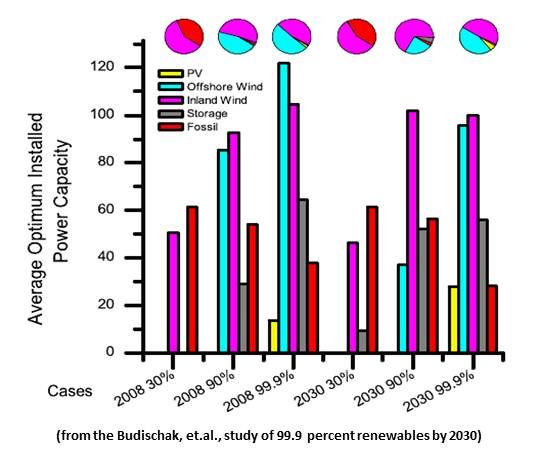Combinations of onshore wind, offshore wind, and photovoltaic solar, paired with battery and hydrogen storage in a widespread grid system, could meet 90 percent to 99.9 percent of expected 2030 demand at almost no increased cost, according to a new study.
“The common view,” University of Delaware researchers noted in their report, “is that a high fraction of renewable power generation would be costly, and would either often leave us in the dark or would require massive electrical storage.”
The priority of the Regional Renewable Electricity Economic Optimization Model (RREEOM) was to see if demand could be met largely with renewables at an affordable cost.
To model that, the researchers incorporated into RREEOM the “four known options: geographical expansion, diversifying resources (e.g., solar plus wind), storage, and fossil backup.”
The model used prices that left out federal and state subsidies but included the costs of fossil fuel externalities.

With storage, according to report co-author Cory Budischak, “we can run an electric system that today would meet a need of 72 gigawatts 99.9 percent of the time, using 17 gigawatts of solar, 68 gigawatts of offshore wind, and 115 gigawatts of inland wind.”
Reliability in a fossil fuel-based system, in which the operating principle is “burn when needed,” requires no computers, digital high-speed communications, or weather forecasting, the report noted. But “the ability to reliably meet load will still be required of systems in the future, despite the variability inherent in most renewable resources.”
To approximate a grid operator’s real world imperative to keep the lights on, the researchers modeled into RREEOM the PJM Interconnection system, a thirteen-state load that accounts for about 20 percent of U.S. electricity demand at approximately $0.1745 per kilowatt-hour.
The transmission model was limited to PJM’s grid and ignored reserve requirements, within-hourly fluctuations and ramp rates, all of which, it assumed, would be easily met with the hypothesized storage.
The varying sufficiencies and costs of more than 28 billion different combinations of renewables and storage were studied over a hypothetical four-year (35,040-hour) time period using actual PJM historical data to approximate real demand and real weather patterns. Historical insolation and wind data from DOE and NOAA were used for each hour being modeled.

“We find that 90 percent of hours are covered most cost-effectively by a system that generates from renewables 180 percent of the electrical energy needed by load, and 99.9 percent of hours are covered by generating almost 290 percent of need. Only nine hours to 72 hours of storage were required to cover 99.9 percent of hours of load over four years,” the report calculated.
So much free fuel from renewables would be available across the geographically dispersed 72-gigawatt PJM grid region that it would not only almost eliminate the need for natural gas reserves, but would also keep the power price low and minimize the need for incurring the cost of battery storage.
The result would be electricity at very near current prices supplied by between 90 percent and 99.9 percent renewables, because “over-generation is cost-effective at 2030 technology costs even when all excess is spilled. If excess generation displaces heating fuels, the cost is lowered further.”
Drawing on the “excess generation of renewables is a new idea,” the study went on, “but it is not problematic or inefficient, any more than it is problematic to build a thermal power plant requiring fuel input at 250 percent of the electrical output, as we do today.”
When there was excess generation, the model stored it. When there was inadequate supply, the model first used the stored generation and then, in a very few instances, natural gas for heating.
Cost assumptions, based on referenced studies, included improved renewables technologies and economies of scale but no unforeseen breakthrough changes. “At 2008 technology costs, 30 percent of hours is the lowest-cost mix we evaluated. At expected 2030 technology costs, the cost-minimum is 90 percent of hours met entirely by renewables. And 99.9 percent of hours, while not the cost-minimum, is lower in cost than today’s total cost of electricity.”
The most potentially controversial assumptions in the study were 1) that the price of renewables will be 50 percent lower by 2030, though operations and maintenance costs remain constant, and 2) that fossil fuel prices will include external costs now paid by taxpayers and health insurers [quite an assumption, even with a carbon tax -- Editor].
Renewable resource supply is adequate, the researchers noted, referencing studies that concluded “a shift to renewable power will increase the energy available to humanity.” Such studies have shown, the report noted, “that global energy demand, roughly 12.5 terawatts increasing to 17 terawatts in 2030, can be met with just 2.5 percent of accessible wind and solar resources, using current technologies.”
A study from Stanford’s Mark Jacobson and Mark Delucchi, the study noted, used eight renewables in conjunction with increased transmission and vehicle-to-grid storage technology to meet the entire world’s electricity needs.



